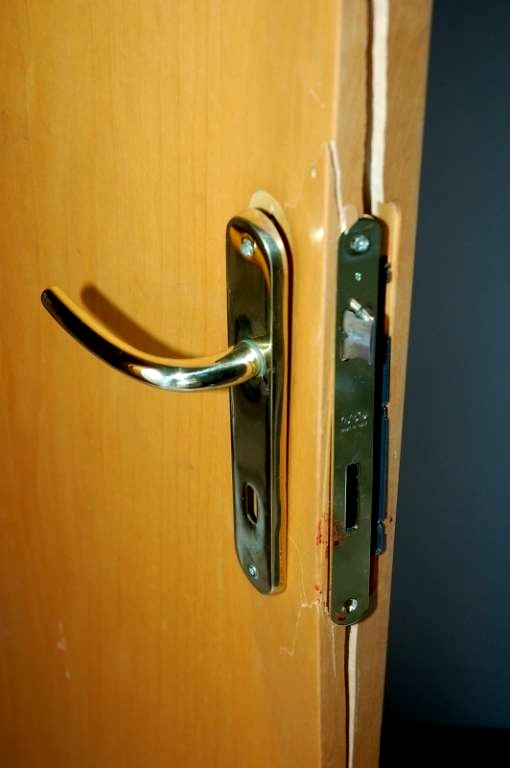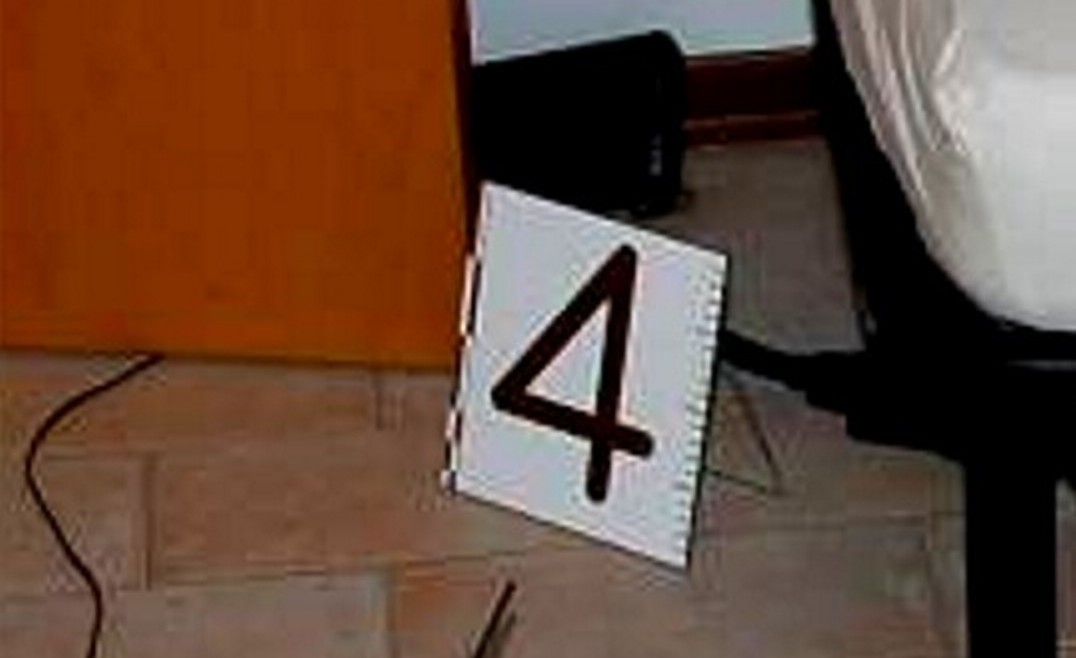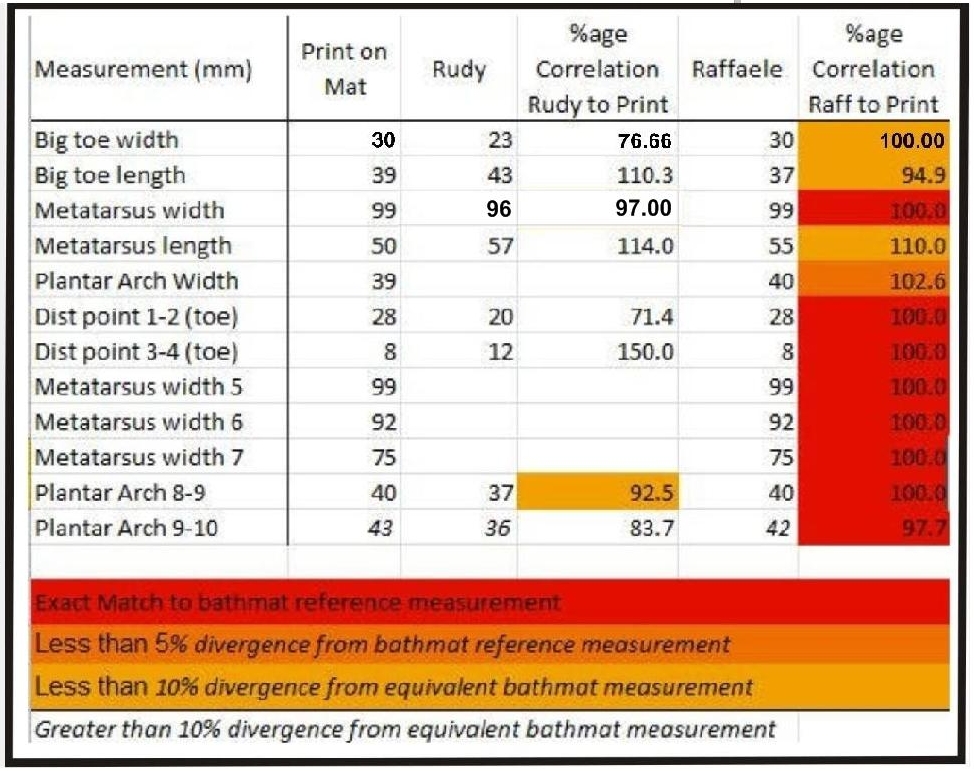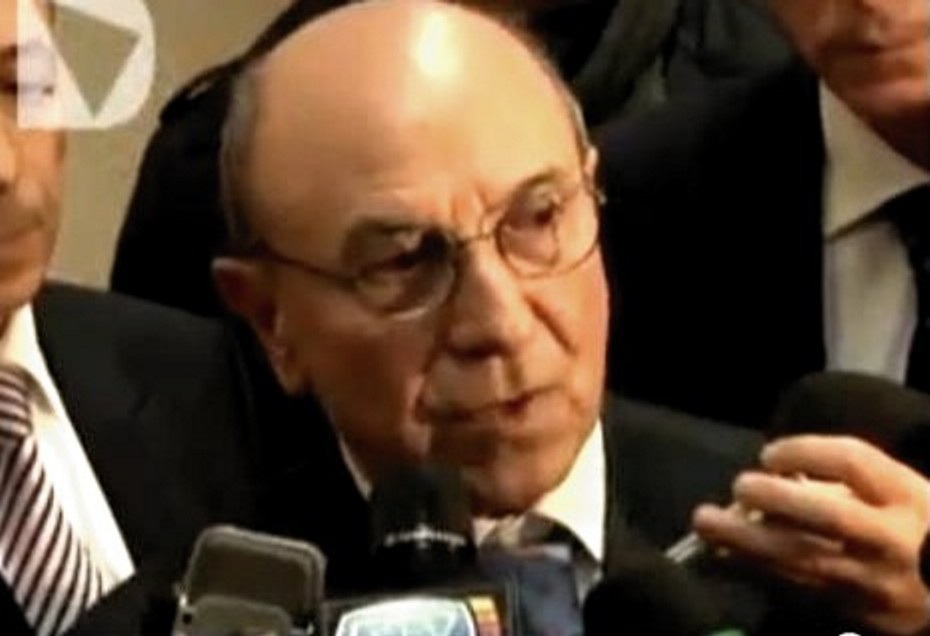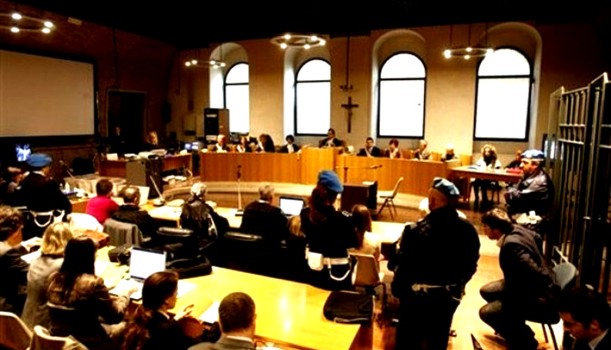
Category: 4 No firm DNA hoax
Wednesday, July 24, 2013
How The Clean-Up And The Locked Door Contribute To The Very Strong Case For Guilt
Posted by James Raper
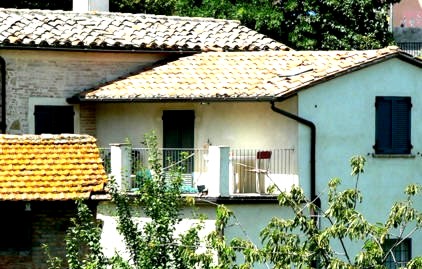
On the 30th September the appeals of Amanda Knox and Raffele Sollecito against the convictions they received at the first instance trial will resume, this time in Florence.
This follows the annulment by the Supreme Court of the acquittal verdicts rendered by the Appeal Court presided over by Judge Pratillo Hellmann. There is one conviction not under appeal. This is Knox’s conviction for calunnia, which is now definite.
They are therefore both currently convicted of murder and sexual assault, and a number of lesser charges, amongst which there is the simulation of a burglary “to ensure impunity for themselves from the felonies of murder and sexual assault, attempting to attribute the responsibility for them to persons unknown who penetrated the apartment to this end”.
There is one activity, for which there is evidence, with which they were not charged (perhaps either because it was redundant or not a criminal offence) though this was likewise to ensure impunity for themselves.
This is the partial clean up at the cottage and it is this with which I intend to deal. I want to highlight salient observations which have been under discussion here and elsewhere and some of which may be well known to readers, but perhaps some not, or have been forgotten about. Once again, in many cases, I am merely a conduit for the observations of others, not least the first instance trial judge Giancarlo Massei.
So let”˜s consider the observations and in doing so we can also throw some more light on the lone wolf theory.
1. Take a look at the bloody footprint
This is, of course, the bloody footprint on the bathmat in the small bathroom right next to Meredith’s room.
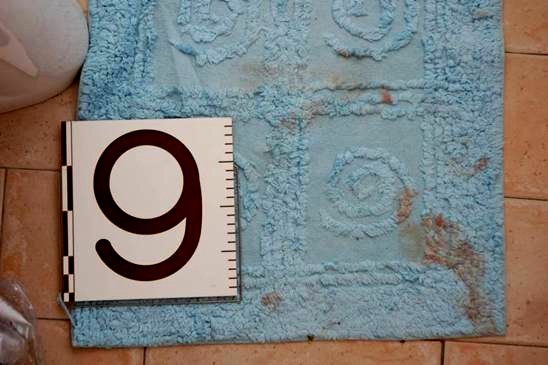
The heel of the right foot, if it had blood on it, is missing from where it should be on the tiled floor. It is difficult to imagine, given that the imprint of the foot on the mat is contiguous with the edge of the mat, that there was not at least some blood on the remainder of the foot such that there must have been at least some blood deposited on the floor.
Just as difficult to imagine that casual shuffling about on the bathmat would have removed the blood so as to render it “invisible” to the use of luminol.
Of equal relevance is that there were no connecting bloody footprints. Why not?
The defences have an improbable theory - that Guede, despite his homicidal rage, was smart enough to hop about on his left foot with a clean shoe on, and the other bare but covered in blood, and that having by this means entered the bathroom and washed his bloody right foot, disastrously leaving his (supposed) imprint there in the process, he then returned to Meredith’s bedroom inadvertently standing in blood with his left shoe and leaving with a trail of bloody left shoe prints - in which case the exercise of washing his foot was entirely in vain, on two counts, after all that careful hopping around.
Neither is it entirely clear why his right shoe came off in the first place.
It is far more probable that the inevitable bloody prints were deliberately and carefully removed. The reason for doing this was not just to conceal who would have made them (the print on the bathmat was, after all, left in situ) but, from a visual perspective, to conceal any blood that might be noticeable and alarming to anyone approaching Meredith’s room. Guede’s bloody shoeprints in the corridor were visible but only on close inspection.
2. Take a look at the bathroom door
Specifically the internal (hinge) side of the bathroom door. Take a look at this photograph.
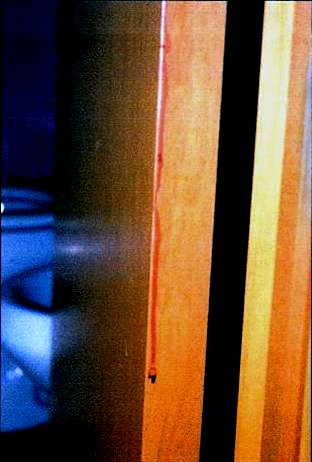
We see a long streak of dried blood. Clearly the blood has flowed some distance under the influence of gravity and we can see that it looks slightly diluted, with red corpuscles gathering towards the tip of the streak. A drip of that size does not appear from nowhere.
Indeed it is difficult to imagine how the blood got there unless it was part of a larger area of blood which most likely was on the face of the door and which was swiped to the right and over the edge of the face of the door. The cloth or towel used to do this was wet accounting for the slight dilution and length of the streak.
3. Take a look at Meredith’s door
It is interesting, is it not, that there is blood on the inside but not on the outside? The outside:
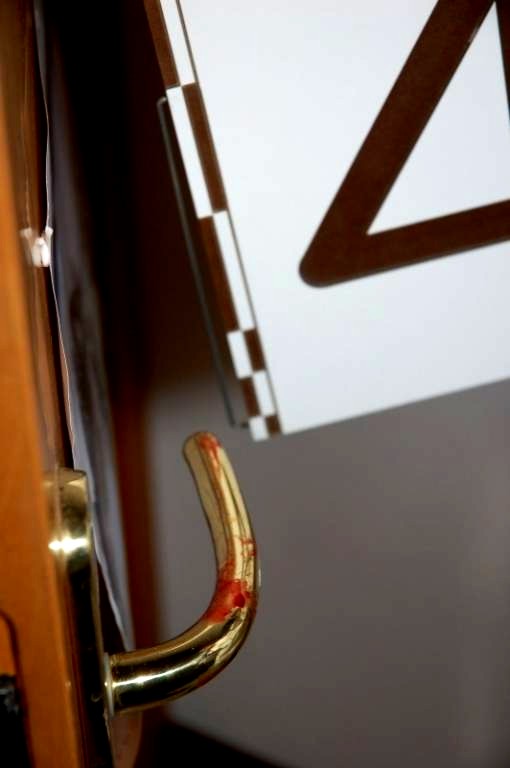
It is difficult to see how and why Guede touched the inside handle with a bloody hand (was it shut and if so, why?) and then closed the door to lock it without leaving a trace on the outside face of the door. Possibly he might have changed hands. The answer might also be that he visited the bathroom to wash his hand as well as his foot, save that none of his DNA was recovered from the spots and streaks of diluted blood in the washbasin, whereas Knox’s DNA was. All the more surprising given that Guede shed his DNA in Meredith’s room.
We see some blood on the edge of the door which again might be the remnant of a trace on the outside face.
4. Take a look at Amanda Knox’s lamp.
This was found inside Meredith’s room behind the door. Meredith also had a similar lamp which was resting on it’s base on the floor by her bedside table.
The presence and location of Knox’s lamp is obviously suspicious. Had Meredith borrowed Amanda’s lamp because her own was not working, then it would not have been in the position it was found but on or more likely knocked over and lying beside the bedside table since the violence appears to have been concentrated in that area of the room.
Had Meredith’s lamp been on the bedside table then likewise it too would most likely have been knocked over in her life and death struggle with her sole assailant (there are blood streaks on the wall just above) and it would not have ended up sitting upright on it’s base.
Both lamps were probably used to check the floor of Meredith’s room after the event and Knox’s lamp was probably sitting upright until it was knocked over by the door being forced open.
This is Meredith’s lamp by the bedside table.
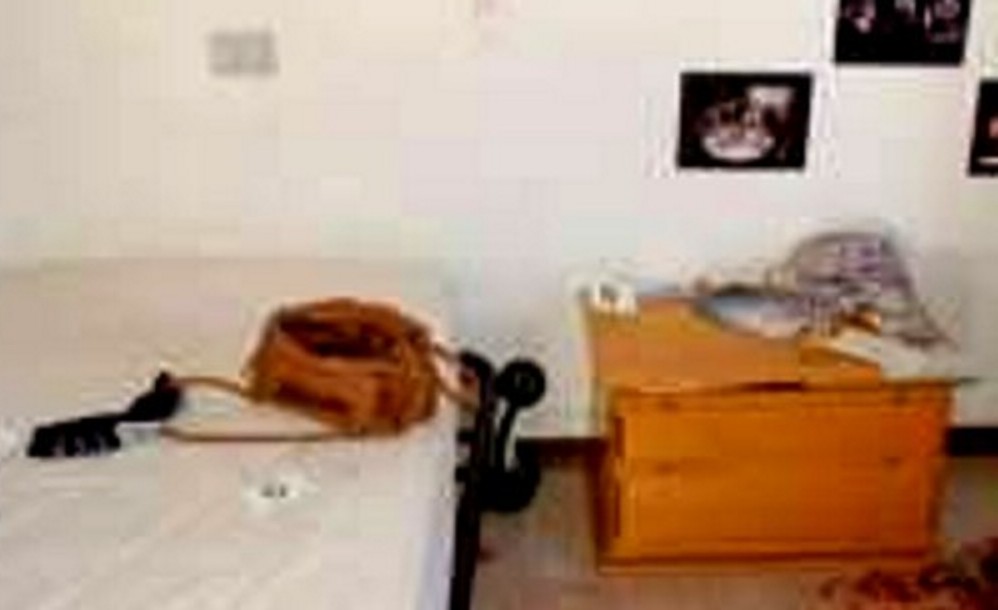
And this is Knox’s lamp by the foot of the bed.
5. Take a look at what luminol revealed
We can state with confidence that luminol (extremely sensitive to and typically used to identify blood that has been wiped or washed away) discovered :-
(a) three bare footprint attributable to Knox, one in her bedroom and two in the corridor, and
(b) two instances of the mixed DNA of Meredith and Knox, one in Filomena’s bedroom and one in the corridor.
(c) a footprint attributed to Sollecito in the corridor.
I have covered a number of elements strongly suggesting that there was at least a partial clean up, not of “invisible DNA” as the Groupies like to mock, but of what would have probably in some cases have been noticeable deposits of blood that would have attracted the eye of anyone entering the cottage and which would certainly have alarmed the observer as being difficult to explain.
Spots of and footprints in blood, not just in the bathroom but outside it, a locked bedroom door with blood on it, and a bathroom door with blood on it’s face.
We can include Knox as one such observer given her e-mail account of having allegedly stopped by the cottage to have a shower and collect some clothing before the discovery of the body. Such physical evidence - had it not been removed - would not have sat easy with that account, however dizzy and naïve Knox presents herself. One can envisage Knox thinking “sorted” - that her story would now work perfectly.
Even so, there were elements that were overlooked, such as Knox’s blood on the washbasin faucet and blood generally in the small bathroom, but a door can be closed and at least these were elements amenable to some form of explanation from her perspective, whether or not convincing, as occurred in the e-mail.
Incidentally in addition to the mixed traces in the small bathroom, Meredith’s blood was found on the light switch and a cotton bud box. I have a hard time imagining what Guede would have wanted with the cotton bud box, less so Amanda given her blood on the faucet, ear piercings and a scratch on her throat. Knox, when asked during her trial, could not recall having switched on the light during her alleged visit to the cottage.
6. Take a look at the items on Knox’s bed
Massei concluded that it was likely that it was Knox who carried out the clean up, which if correct might explain why it was not central to her thinking to dispose of the bathmat with Sollecito’s bloody footprint on it!
Knox was seen by Quintavalle at his store at 7.45 am on the 2nd November, thereby destroying her alibi. He described her as pale faced, exhausted looking, with pale blue eyes. He also added, and he would not have known this from photographs in the newspapers, that she was wearing blue jeans, a grey coat and a scarf, with a hat or cap of some sort.
We can see from the crime scene picture of Knox’s bedroom below, that such items (minus hat or cap) appear to be lying on her bed.
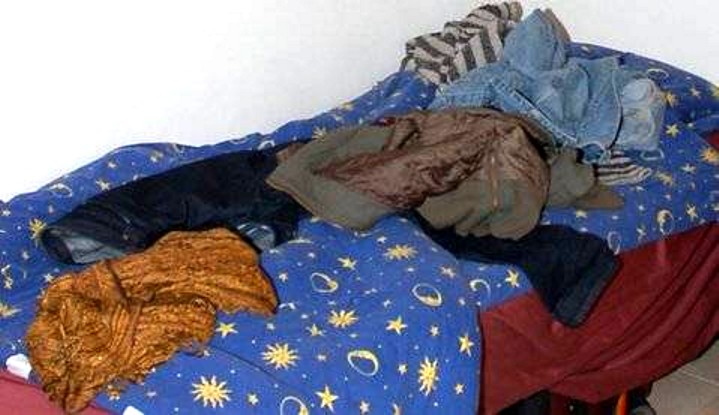
Sollecito did not accompany Knox to the store but this would be because he was known to Quintavalle whereas he was unfamiliar with her. He may however have accompanied Knox to the cottage and/or have acted as look out for her when she was there.
7. Some conclusions
I have included “The locked room” in the title because of a poster’s observation regarding Guede’s bloody left shoeprints exiting Meredith’s room. There is the simple observation that these footprints are going one way only and not towards the small bathroom. But they do not even turn to face Meredith’s door, and again hard to imagine that this could be so if it was Guede who locked her door!
We can rule out Guede as having been involved in any aspect of the clean up precisely because of that trail of footprints and other evidence of his presence left behind.
Now that the travesty of the Hellmann acquittals has been truly exposed Knox and Sollecito face an impossible uphill task.
The clean up and the locked door are just two of many elements in this case which combine together and corroborate each other in a manner that enables us to see the truth beyond a reasonable doubt.
Friday, April 19, 2013
Twenty Forensic Reasons Why Guede Could NOT Have Attacked Meredith Alone
Posted by Cardiol MD
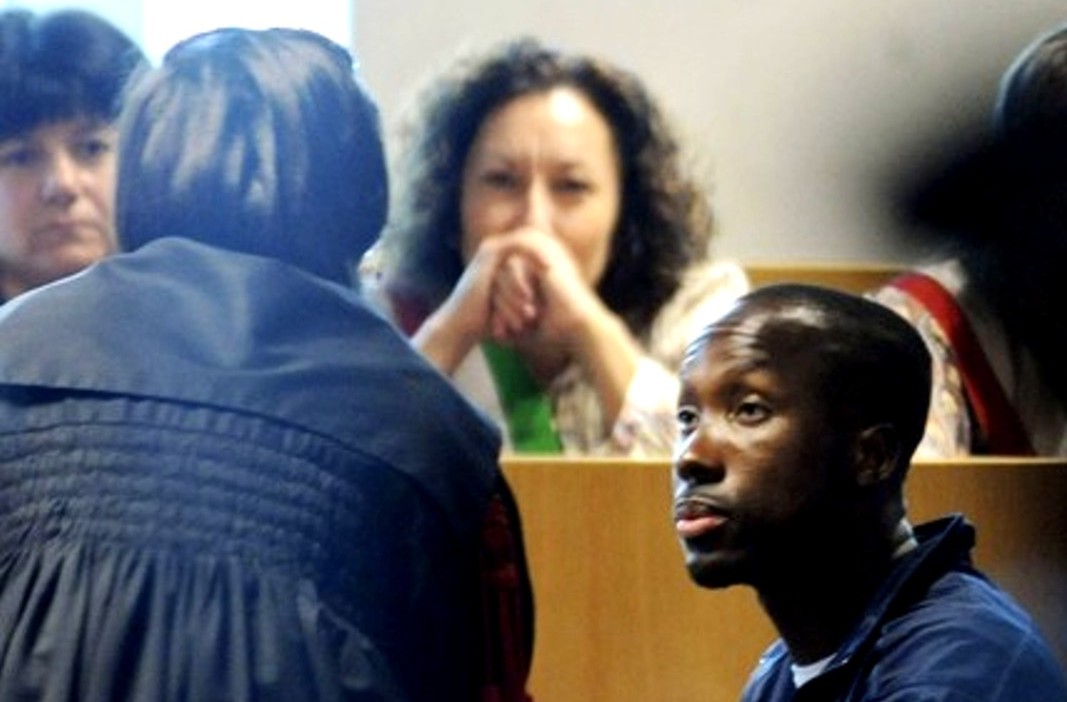
[Bongiorno in 2011 trying to rattle an unshakable Guede claiming Knox and Sollecito did the crime]
1. Guede Persona, An Overview
The convicted murderer Rudy Guede to this day claims that Meredith let him into the house, so we cut him no slack for that.
But at the same time he was no drifter or serial knife carrier, he had no police record in 2007 (unlike Knox and Sollecito), and no drug dealing or breaking-and-entering has ever been either charged or proved.
In October 2008 Judge Micheli mistrusted and sharply rebuked a witness who claimed it just might have been Guede who broke into his house.
Guede seriously discounted his role on the night of Meredith’s death, but some physical evidence (not a lot) proved he had played a part in the attack. Thereafter his shoeprints lead straight to the front door.
2. Moving Target In Court
Neither Judge Micheli nor Judge Massei nor the Supreme Court believed he acted alone or had any part in the very obvious cleanup that had been carried out.
The Knox and Sollecito defenses failed miserably to prove he climbed in Filomena’s window, and despite much innuendo they never really tried to prove he was a lone attacker.
That is why in 2011 we saw two of the most bizarre defence witnesses in recent Italian legal history, the jailbirds Alessi and Aviello, take the stand
Alessi became so nervous making his perjured claim that Guede told him Guede did it with two others that he was physically sick and had to take time off from the stand.
Aviello loudly proclaimed that his brother and another did it (not Guede) and then claimed the Sollecito family via Giulia Bongiorno floated bribes in his prison for false testimony.
Tellingly, although Bongiorno threatened to sue Aviello, she never has. Even more tellingly, Judge Hellmann himself initiated no investigation and simply let this serious felony claim drop dead.
Here is a far-from-exhaustive list of 20 reasons why Rudy Guede could not have acted alone. Also why not one scrap of evidence has ever been found for any two other than Knox and Sollecito themselves.
3. Twenty Lone-Wolf Disproofs
1. Guede’s Final Appeal Report said Meredith sustained 43 wounds
The testimony at the 2009 trial about the 43 wounds was presented in closed court out of humane respect by the jury for the feelings of Meredith’s family.
So even the diligent and trustworthy Italian media mostly missed this, as they were locked outside.
Mention of the 43 wounds was omitted from the 2009 Massei Trial Report and also from the 2011 Hellman Appeal Report.
Its inclusion in the December 2010 in Judge Giordano’s Supreme Court report on Guede’s final appeal reflects the report’s excellent factual completeness.
The PMF translation reads, in relevant part:
The body presented a very large number of bruising and superficial wounds – around 43 counting those caused by her falling – some due to a pointed and cutting weapon, others to strong pressure: on the limbs, the mouth, the nose, the left cheek, and some superficial grazing on the lower neck, a wound on the left hand, several superficial knife wounds or defence wounds on the palm and thumb of the right hand, bruises on the right elbow and forearm, ecchymosis on the lower limbs, on the front and inside of the left thigh, on the middle part of the right leg, and a deep knife wound which completely cut through the upper right thyroid artery fracturing the hyoid bone, a wound which caused a great deal of bleeding.
Including the number of minutes occupied by an initial verbal confrontation, the escalation of that confrontation into taunting and then the physical attack, leading to the infliction of 43 wounds, and to the fatal stabbing, how many minutes would all of this occupied?
The prosecution estimated it took fifteen.
2. Meredith had taken dance classes and played football & karate)
See the Massei Translation, p23.
Every day Meredith called her family, with whom she had a very close relationship. She had taken classes in dance and played sports (football, karate); she was a strong girl, both physically and in terms of temperament (cf. statements by her mother and by her sister Stephanie, hearing of June 6, 2009).
3. Meredith was a strong girl, physically and in temperament
See the statements by her mother and by her sister Stephanie (hearing of June 6, 2009). and description of her karate. (Massei Translation, pp23, 164, 366, and 369).
With regard to the totality of these circumstances, it must be considered that Meredith could only have made an outright refusal to Rudy’s advances and in doing so could also count on her slim [fit] physique, which the photos allow [one] to understand, [and] on her good athletic training (other than dance she had also done sports characterised by a certain physicality such as football, and had even taken a course in karate), sustained by her strong character.
4. Meredith must have been “strongly restrained”
See the Massei Translation, p371; p399, in the Italian original.
Conversely, considering the neck wounds sustained, it must be believed that Meredith remained in the same position, in a standing position, while continuously exposing her neck to the action of the person striking her now on the right and now on the left. Such a situation seems inexplicable if one does not accept the presence of more than one attacker who, holding the girl, strongly restrained her movements and struck her on the right and on the left because of the position of each of the attackers with respect to her, by which it was easier to strike her from that 372 side. One of these attackers was Rudy and the others were those who allowed Rudy to enter the house and who were with him in the house and who, in order to lead the nvestigations astray, then organised the staging of the broken window and the mess in Romanelli’s room: Amanda Knox and Raffaele Sollecito, according to all that has already been shown.
5. Meredith remained virtually motionless throughout the attack
That was in spite of Meredith’s physical and personality characteristics [Massei Translation p369] [Massei Translation p370-371].
A first indication to be taken into account is Meredith’s physical build: the photographs of her body and the data of her approximate height and weight reveal a physique with “normotrophic muscular mass and normally distributed subcutaneous fat” (cf. declarations Lalli p. 3), a slim physique which would have permitted Meredith to move with agility. To this must be added the declarations of the parents and the sister of Meredith. Her mother, Arline Carol Mary Kercher, recalled that Meredith had practised football and karate (p. 7 hearing 6 June 2009), and her sister, Stephanie Arline Lara, stated that Meredith also did boxing, if only the once, and that “physically she was very strong” (p. 20, hearing 6 June 2009). Also her father, John Leslie Kercher, declared that his daughter was quite strong and had taken a course in karate (p. 23 hearing 6 June 2009). It has also been noted that Meredith was not in bed and undressed when the “advances” and the attempts to subject her will commenced. Being still dressed and awake, and since it must be excluded because of what has been said above that the violent action could have taken place with Meredith lying on the bed, it is considered that she, who was sober and fully conscious since no traces indicating either the use of drugs or the abuse of alcohol were found, would have opposed a firm resistance, as she could claim a strong physique, experienced in self-defence by the lessons in karate that she had taken.
6. The defensive wounds were almost non-existent
See the report of Dr Lalli, pp. 33, 34, 35 with the relevant photos. Massei Translation p370.
The signs of this resistance, however, consist in a scream, the scream heard by Nara Capezzali at around around 23:30 and by Maria Ilaria Dramis when, having gone to bed at 22:00 pm, she awoke at a later time which she was not able to quantify; they consist also in some tiny defensive wounds: one on the palm of her [396] right hand of a length of .6cm showing a tiny amount of blood; another on the ulnar surface of the first phalange of the second finger of the left hand, also of length .6cm; another on the fingertip of the first finger with a 370 superficial wound of .3cm, and another tiny wound corresponding to the fourth radius. Compared with these almost nonexistent defensive wounds (cf. report of Dr Lalli, pp. 33, 34, 35 with the relevant photos), there is an injured area which is impressive by the number, distribution and diversity, specifically of the injuries (bruises and wounds) on the face and neck of Meredith.
7. One killer couldn’t inflict 43 wounds with so few defensive wounds.
See the Massei Report quotes above.
8. There must necessarily have been two knives at the scene of the crime
See the Massei Translation p377.
Even this consideration, therefore, leads one to hold that the biological trace attributable to Amanda and found on the knife handle, could have derived from the use of the knife for the purpose of striking, rather than to cut food; it could have derived, therefore, from the harmful action carried out against Meredith and as a consequence, a biological trace attributable to Meredith remained in the tiny striations present on the face of the blade, in spite of the subsequent cleaning, and which does not appear otherwise explainable as to how, in this regard, it was to be found there (Meredith had never been in Raffaele Sollecito’s house and could never have used this knife). Moreover, the knife Raffaele Sollecito carried with him had a definitely shorter blade as has been seen than the length that would have been necessary for causing the deeper resulting wound, with a depth of 8cm, and therefore, there must necessarily have been two knives at the scene of the crime, first one, and then the other, being used against Meredith.
9. A lone killer would need one hand/arm or both to restrain Meredith
So how could he use 2 knives? To use 2 knives a lone killer would have to place 1 knife down, leaving blood-stain[s] wherever it was placed, and then reach for the other knife.
Even wiping the blades on the killer’s clothes, using the one hand, and later scrubbing of the knives would not erase all the blood, as has already been demonstrated.
10. Two killers could divide attack, one holding Meredith, both holding knives
Meanwhile the other killer used one hand/arm to restrain Meredith, and the other hand to use the various knives. Could a lone killer accomplish all that?
11. Meredith’s shoes, pants and underwear had been removed
See the Massei Translation p.370
“It is impossible to imagine in what way a single person could have removed the clothes that Meredith was wearing (shoes, pants and underwear), and using the violence revealed by the vaginal swab, could have caused the resulting bruises and wounds recalled above, as well as removing her sweatshirt, pulling up her shirt, forcing the bra hooks before tearing and cutting the bra.” [Massei Translation p.370]
12. Meredith’s sweatshirt had been pulled up and removed.
See the [Massei Translation p.370
Furthermore, it is impossible to imagine in what way a single person could have removed the clothes that Meredith was wearing (shoes, pants and underwear), and using the violence revealed by the vaginal swab, could have caused the resulting bruises and wounds recalled above, as well as removing her sweatshirt, pulling up her shirt, forcing the bra hooks before tearing and cutting the bra.
13. Meredith’s bra had been forcibly unhooked
See the Massei Translation p.370
14. Meredith’s bra had been torn
See the Massei Translation p.370
15. Meredith’s bra had been cut
See the Massei Translation p.370
16. Violence to Meredith was revealed by the genital swab.
See the Massei Translation p.370
17. In Hellmann appeal RS’s lawyers didnt allege lone killer
They themselves brazenly introduced false testimony to the effect that there were two other killers.
18. Even Hellmann didn’t deny the complicity of AK and RS
Even H/Z seemed to conclude they are probably guilty, but not beyond a reasonable doubt:
“| in order to return a guilty verdict, it is not sufficient that the probability of the prosecution hypothesis to be greater than that of the defence hypothesis, not even when it is considerably greater, but [rather] it is necessary that every explanation other than the prosecution hypothesis not be plausible at all, according to a criterion of reasonability. In all other cases, the acquittal of the defendant is required.” [H/Z p.92]
19. Judge Micheli, in Guede’s trial, found that Guede did not act alone
And that the evidence implicated Amanda Knox and Raffaele Sollecito as accomplices of Rudy Guede in the murder of Meredith Kercher.
20. Massei found that the evidence implicated AK and RS
He concluded they were joint perpetrators with Rudy Guede in the murder of Meredith Kercher.
4. Obvious Conclusions
Is it really reasonable to claim as Sollecito did in his 2012 book that Guede was a lone killer?
Doesn’t all this contradict the lone-killer theory, beyond a reasonable doubt?
Monday, April 08, 2013
Experienced Trial Lawyer: There’s Far More Evidence Than UK/US Courts Need For Guilt
Posted by SomeAlibi
The false claim “there is no evidence”
Some amateur supporters of Knox and Sollecito have committed thousands of hours online to try and blur and obfuscate the facts of the case in front of the general public.
Their goal is simple: to create an overwhelming meme that there is “no evidence” against the accused, and thereby try to create a groundswell of support. Curt Knox and Edda Mellas and Ted Simon have all made this “no evidence” claim many times.
At least some some of the media have eagerly swallowed it.
The amateur PR flunkies make up myriad alternate versions of what created single points of evidence, often xenophobic scare stories designed to trigger emotional reactions, which they hope will be repeated often enough to become accepted as “the truth”.
And where things get really tricky, another time honored tactic is to go on at great length about irrelevant details, essentially to filibuster, in the hope that general observers will lose patience with trying to work it all out.
But time and again we have shown there is actually a great deal of evidence.
Evidence is the raw stuff of criminal cases. Let me speak here as a lawyer. Do you know how many evidence points are required to prove Guilt? One evidence point if it is definitive.
A definitive evidence point
If you’re new to this case or undecided, what is an easy example of ONE definitive evidence item that might stand alone? Might quickly, simply, and overwhelmingly convince you to invest more time into understanding the real evidence, not that distorted by the PR campaign?
In fact we have quite a choice. See the footprint which was second on that list.
Now see the table above. I recommend the use of this table of measurement to avoid the lengthy back and forward of narrative argument which so lends itself to obscuring the truth. I would like to present you with this single table of measurements to give you pause to question whether this line that there is “no evidence” is really true or whether it might be a crafted deception.
I present here a summarized view of critical evidence which suggests with devastating clarity that Raffaele Sollecito was present the night of the murder of Meredith Kercher. No lengthy text, no alternate versions, just measurements.
This FIRMLY places Sollecito in the very room where Meredith was attacked and killed.
In the small bathroom right next to Meredith’s bedroom was a bathmat. On it was found a bloody naked right footprint of someone walking straight towards the shower in the bathroom. The blood is that of Meredith.
The footprint is not Amanda Knox’s - it is too big - but we can compare it to the prints taken of Rudy Guede and Raffaele Sollecito.
In Judge Massei’s report the multiple measurements were detailed in the narrative over many sentences and, in that form, their immediate cumulative impact is less obvious. It is only by tabulating them, that we are forcefully hit by not one but two clear impressions:
The measurements are extremely highly correlated to the right foot of Raffaele Sollecito in twelve separate individual measurements. In themselves they would be enough for a verdict of guilt in all but a few court cases.
But they also show a manifest LACK of correlation to the right foot of Rudy Guede, the only other male in that cottage on the night. Have a look for yourself.
If you were the prosecution, or indeed the jury, and you saw these measurements of Raffaele’s foot versus the print, what would you think? Answer the question for yourself based on the evidence admitted to court.
Then, if you compare further, exactly how plausible do you find it that the measurements of the bloody imprint are Rudy Guede’s instead?
Not only are some of the individual measurements of Rudy’s imprint as much as 30% too small, but the relative proportions of length and breadth measurements are entirely wrong as well, both undershooting and overshooting by a large margin (70% to 150%).
Conclusions that must follow
Presented with those numbers, would you consider those measurements of Rudy Guede’s right foot to show any credible correlation to those of the footprint on the mat?
Supporters of the two have tried frantically to create smoke screen around this - the wrong technique was used they say (ruled not so by the court) / they are the wrong measurements (all 32 of them? that Raffaele’s are matching exactly or within a millimetre but Rudy’s are out by as much as -30% to +50%...?).
The severity of the impact on the defence is such that there was even a distorted photoshopped version circulated by online supporters of Raffaele and Amanda until they were caught out early on in coverage. But it is hopeless, because these are pure measurement taken against a scale that was presented in court and the data sits before you.
Have a look at the measurements and understand this was evidence presented in court. Whose foot do you think was in that bathroom that night? Rudy Guede? Or was it Raffaele Sollecito on twelve counts of measurement?
And if you find for the latter, you must consider very seriously what that tells you both about the idea there is “no evidence” in this case and who was in the cottage that night…
Tuesday, March 26, 2013
More Pervasive Myths We Will Nail In Our Various Hoaxes Series In Due Course
Posted by Our Main Posters

We hope you made it through those amazing Powerpoints on the case for guilt introduced in the post directly below.
We have created around two dozen other Powerpoints also. Here are all Kermit’s Powerpoints and here are all other Powerpoints.
Below are summaries of some more key and very pervasive myths which you can easily spot in today’s media in the US and UK (though never in Italy) which we will nail in depth soon in other longer posts.
The real hard truths can all already be found here on TJMK if you search for them. Please feel free to email us if you need some quick guidance.
1) That Knox and Sollecito maybe face a “retrial”
Rubbish. At most they face a re-run, done properly, of a poorly managed, legally and scientifically incompetent, and highly biased first appeal. It SHOULD look like any US or UK appeal: limited, fast, focusing only on a few points, no consultants, no witnesses, no attempt to run a new first-level trial.
2) That any such “retrial” is a case of double jeopardy
Rubbish. Under Italian law Knox and Sollecito still stand accused of murder and other crimes until the final appeal court (in this case the Supreme Court) signs off, so they were NEVER found “innocent, end of story” at first appeal level. There’s no question of double jeopardy; and the exact-same rules apply in the US.
3) That Amanda Knox was forced into “confessing”
Rubbish. This is the misleading label for her framing of Patrick Lumumba. She spilled the beans fast and vociferously (and repeatedly) after Sollecito who was being interrogated in another room sold her out and said she had made him tell lies. Interrogations were short, she had an interpreter, she was not interrogated as a suspect without a lawyer, and she had refreshments.
4) That all the DNA evidence was thrown out by Hellmann
Rubbish. Hellmann (who is now edged out in disgrace) and Zanetti were not criminal judges, and this was their first DNA case. They were totally at sea. By innuendo, two consultants, illegally appointed and ill qualified, tried to make out there was possible contamination. They proved nothing. They ADMITTED Meredith’s DNA was on the big knife and that Sollecito’s DNA was on the bra clasp. There was lots of other incriminating DNA evidence outside Meredith’s door.
5) That “the” prosecutor was rogue, satanist, and out of control.
Rubbish. The lead prosecutor at trial (Mignini) is straight as an arrow and very admired, and has no interest in satanism. His work was checked by a co-prosecutor, other prosecutors, and many judges. He is in line for a major promotion, and has no dark cloud hanging over his head. The Supreme Court TWICE came down strongly in his favor in the part several weeks, and he is about to be promoted to Deputy Chief Prosecutor for the Province of Umbria.
Final warning:
Disregard everything coming from ABC, CNN, and any Seattle TV station. They are highly biased for commercial reasons, they don’t know the case, and they have essentially been serial-lying to the American public.
Monday, February 18, 2013
Raffaele Sollecito Now Under Formal Investigation For New Crimes Apparently Unprecedented
Posted by Our Main Posters
Breaking news. The Chief Prosecutor for Tuscany Dr Quattrocchi (above and below) has taken this investigation of Sollecito behind the scenes. Dr Quattrocchi is actually under no compulsion to make any of the Perugia and Rome complaints public before his investigation is complete. He has ordered all documents removed from the public domain. This is specifically to give the defense and their PR no advantage, and to make sure those others in Perugia who are going to complain about being defamed do so without harm.
Overview
This is a contempt of court case as court officials have been impugned. This is Wikipedia’s definition of “contempt of court” under US and UK common law.
Contempt of court is a court order which in the context of a court trial or hearing, declares a person or organization to have disobeyed or been disrespectful of the court’s authority.
Often referred to simply as “contempt,” such as a person “held in contempt,” it is the judge’s strongest power to impose sanctions for acts which disrupt the court’s normal process.
A finding of contempt of court may result from a failure to obey a lawful order of a court, showing disrespect for the judge, disruption of the proceedings through poor behaviour, or publication of material deemed likely to jeopardize a fair trial.
A judge may impose sanctions such as a fine or jail for someone found guilty of contempt of court.
We may now find out much more about the equivalent under Italian law.
When Raffaele Sollecito and Amanda Knox were released at the end of 2011, the prosecution filed a Supreme Court appeal within the allotted period. This automatically meant that Sollecito and Knox still stood accused of crimes until the Supreme Court finally signs off.
Typically Italian defendants in such a legal status get good legal advice, on the lines of “Shut up and keep your heads down. We need to be the only ones doing the talking here.”
Here such advice may or may not have been forthcoming, but the public record strongly suggests it was not. In fact Sollecios entire legal team is credited by both himelf and his shadow writer Andrew Gumbel with helping. This is what Gumbel wrote in his Acknowledgments:
Donatella Donati in Luca Maori’s office gave up many hours to make the official documentation available and to present it all in a cogent order. She’s a largely unsung hero in this story and deserves recognition for her extraordinary efforts on Raffaele’s behalf. Giulia Bongiorno, Luca Maori, and Tiziano Tedeschi answered questions and made comments on parts of the manuscript.
In the same Acknowledgments Sollecito credits the following.
I was lucky to have a crack legal team who showed their devotion to the truth and, in some cases, did not even request payment. The team of lawyers and consultants included Adriano Tagliabracci, Francesco Vinci, Bruno Pellero, Francesco Introna, Giulia Bongiorno, Maurizio Parisi, Daniela Rocchi, Luca Maori, Donatella Donati, Marco Brusco, Aldo Poggioni, Delfo Berretti, Tiziano Tedeschi, and Antonio D’Ambrosio.
Interestingly, Luca Maori has already left Sollecio’s legal team, and all eyes are now on Giulia Bongiorno. Buy plenty of popcorn. Lawsuits could fly between lawyers and family.
Since the end of 2011 Curt Knox’s forces seem to have have gone full steam ahead with their own vilifications of the Italian prosecutors, police, judges, and witnesses - in fact almost anyone who had any role in 2009 in finding them guilty, or came to believe that was a fair finding. Ourselves included.
In late 2012 Curt Knox apparently invited all the most fervent of these attackers to Seattle, including Frank Sforza and Bruce Fischer, as some sort of reward for their legally very ill-advised campaign. Buy plenty more popcorn. Lawsuits could fly here as well.
Raffele Sollecito’s forces in Italy had been a lot more restrained.
But at a stroke, the shrillness of Raffaele Sollecito leapfrogged that of Amanda Knox’s forces, with the publication of his book Honor Bound by Simon and Schuster in English in the UK and US last September,
INSTANTLY the book became notorious in Italy, because excerpts were read out by an Italian reporter in New York on the national television show Porta a Porta. Raffele Sollecito’s father Francesco was on that show, and he was increasingly forced to admit a key claim in the book was invented. It simply never happened. His son made it up.
The false claim by his son that Francesco was made to repudiate - it reappears over many pages - concerned a claimed deal engineered by his family and offered by the prosecution to Sollecito.
The deal he claimed was to roll over on Amanda Knox, and if Sollecito did so, he would be home free.
Following the Porta a Porta show, the book (obtainable on UK Amazon, where many false claims are repeated in the reviews) began to make its rounds in Italy. It took some time before many official parties accused of crimes by Sollecito obtained copies and started to explore their own legal possibilities. They are apparently still far from finished.
At the end of last week, the Chief Prosecutor for Tuscany Giuseppe Quattrocchi received the first official request from Perugia, which is to investigate 12 very serious claims in the book against the prosecution and the legal institutions of Italy. The complaint nominates a number of witnesses.
The Prosecution office of Florence now has a maximum of six months to investigate whether there is a case against Sollecito and other named parties. If so, they will steer it through the hoops of the Italian process.
The potential ripple effects of this appear to us to stretch on and on. They could come to engulf both legal teams (credited in the book with helping) and all of the PR for both defendants. Sollecito’s publisher and shadow writer are specifically named in the complaint
If Amanda Knox is not let off the hook by the Italian Supreme Court late in March (the outcome we consider most likely, given the great strength of the appeal) the smart way for Knox to go in light of this could be to junk all her websites, her book, and her interviews, and throw her supporters under the bus. Plus maybe get smarter lawyers - the aggressive and inexperienced Dalla Vedova does her no favors.
Keeping Amanda Knox’s head out of this deadly new line of fire may be very late - but maybe better late than never.
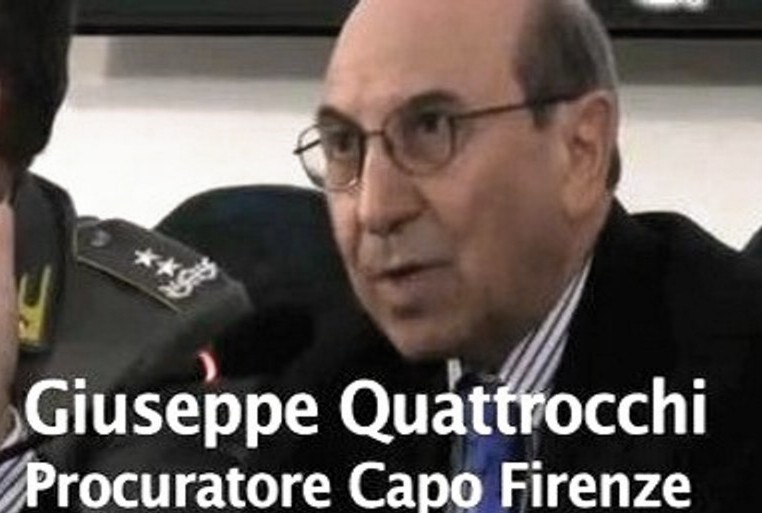
Wednesday, December 12, 2012
Simon & Schuster Seem To Be Seriously Rattled Over Lack Of Due Diligence On Sollecito’s Book
Posted by Peter Quennell
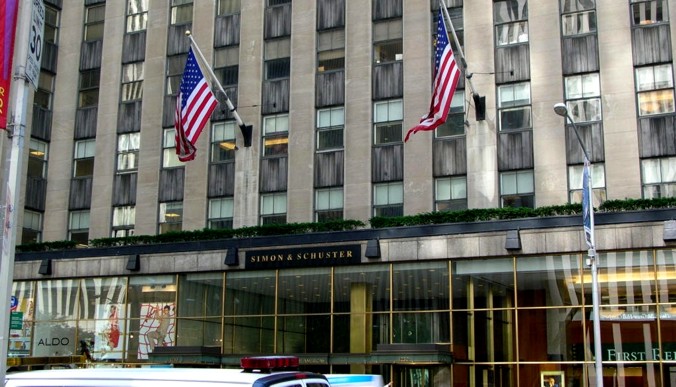
See this emailed exchange which took place late today.
What Simon & Schuster’s agent is complaining about was a chronological reordering (behind the scenes and not linked to from the front page) of these many corrections here. Our Kindle and hardcover copies were legally purchased. Simon & Schuster put about 1/4 of the book on the front of their own website, and Google Books also carries about 1/4 of the book to read free.
Admittedly, our corrections may have been quite a shock. However, we didnt cause the book sales to tank. All of our past posts on Raffaele Sollecito’s book can be seen here.
*******
Mr Eraj Siddiqui
119 South B Street Suite A,
San Mateo, CA 94401
Dear Mr Siddiqui
Thank you for your “Verified DMCA Removal Request from Attributor” copied below.
The book you refer to appears to contain up to 30 instances of criminal defamation under Italian law and literally hundreds of wrong and injurious statements that are hurtful to many fine officials in Italy.
We have full legal rights to point out the myriad mistakes in the book. In fact a defamation of a prosecutor in the book has ALREADY been admitted on Italian national TV by the writer’s own father in Rome.
That Simon & Schuster apparently failed to do their legal and factual due diligence on the book prior to publishing seems to us to be absolutely nobody’s fault but their own. They are hardly new at this game.
Nice try, but sorry, no cigar.
Peter Quennell
*******
Dear Sir/Madam,
I certify under penalty of perjury, that I am an agent authorized to act on behalf of the Rights Holder identified below, the owner of certain intellectual property rights in the Work(s) identified below.
I have a good faith belief that the information contained in this notice is accurate, and that the page or material listed below is not authorized by the Rights Owner, its agents, or the law for use by the individual(s) associated with the identified page listed below or their agents.
To the extent that the Digital Millennium Copyright Act, the European Union’s Directive on the Harmonisation of Certain Aspects of Copyright and Related Rights in the Information Society (2001/29/EC), and/or other laws and regulations relevant in European Union member states or other jurisdictions apply to your service, if at all, I HEREBY DEMAND THAT YOU ACT EXPEDITIOUSLY TO REMOVE OR DISABLE ACCESS TO THE PAGE(S) OR MATERIAL(S) at the Infringing URL(s) identified below.
Note that in some cases the pages/material may have been removed after the sending of this notice but prior to your review.
My contact information is as follows:
Organization name: Attributor Corporation as agent for Simon & Schuster Inc.
Email: .(JavaScript must be enabled to view this email address)
Phone: 650.306.9474
Mailing address:
119 South B Street
Suite A,
San Mateo, CA 94401
Nothing contained in this letter or in any attachments constitutes a waiver or relinquishment of any right or remedy possessed by the Rights Holder, or any affiliated party, all of which are expressly reserved.
My electronic signature follows:
Sincerely,
/Eraj Siddiqui/
Eraj Siddiqui
Attributor, Inc.
*** INFRINGING PAGE OR MATERIAL ***
Infringing page/material that I demand be disabled or removed in consideration of the above:
Rights Holder: Simon & Schuster
Original Work: Honor Bound
Infringing URL: https://truejustice.org/ee/index.php?/tjmksollecitosbook/P0/
Infringing URL: https://truejustice.org/ee/index.php?/tjmksollecitosbook/P5/
Infringing URL: https://truejustice.org/ee/index.php?/tjmksollecitosbook/P10/
Saturday, October 20, 2012
Exploding Nightmare For Lawyers Of The Defense: Torrent of “Mistakes” In Sollecito’s Hapless Book
Posted by Sara
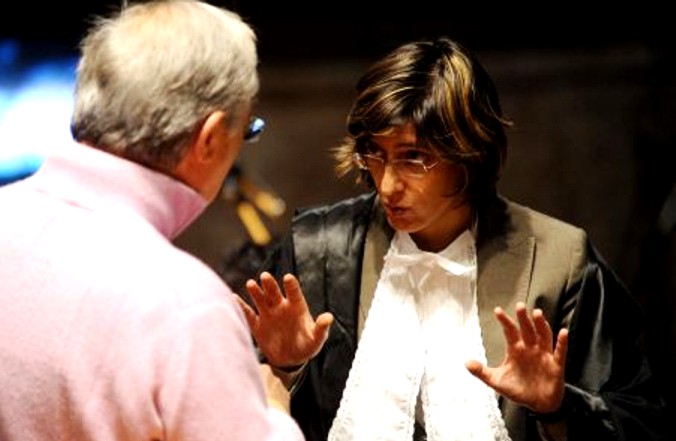
More and more and more wrong facts and libels are being turned up in Sollecito’s pathetic book, both by us here and by an irritated officialdom in Rome and Perugia.
Amanda Knox is rumored to perhaps be mentally unstable and figuratively locked in the attic in Seattle. Now Sollecito seems to have been disappeared back in Italy for his own good as well.
Sollecito’s own lawyers (who have in the past threatened to walk) and his own family have already thrown him to the wolves on Italian TV over just one highly libelous claim and there are an estimated two dozen more still to surface.
Not really a good idea to write a shrill “I’m the real victim here” book unchaperoned, when you have the smug mentality of a 12-year-old. The facts strongly against you. A very bright prosecutor. And a ghost writer whose slobbering over a laughably fictional Sollecito suggests he has a something of a boy-crush.
Raffaele Sollecito has made many stupid claims in his book, but perhaps none is so obvious and more idiotic than his claims about the “lost” emails.
What is it with this guy and the emails? He seems to think (or perhaps, thinks that the readers are stupid enough to believe) that if a computer or a hard drive is destroyed, all the emails in it are lost as well. Come on already, surely they taught him the mechanisms of email in his computer classes.
Look at his statements regarding emails. In chapter 2 (Love and Death) of his book, he describes the morning after the murder -
I’d been up several times in the night””listening to music, answering e-mail, making love””and wanted only to go back to sleep
Right, so he got up many times in the night to answer e-mails. You’d think that this would be his biggest alibi for the night of the murder, right? No, wrong. Raffaele could not prove his alibi because, in his own words -
I did not yet know that the Polizia Postale””supposedly experts in handling technology issues””had seized two of my computers along with Amanda’s and Meredith’s and somehow wrecked three of the four hard disks while trying to decipher them. The bottom line was that the damaged disks were now deemed unreadable. That left just my MacBook Pro to provide an alibi for the night of the murder.
But modern emails DON"T EVEN RESIDE on local hard drives unless one DELIBERATELY downloads them. And even if one does (and hardly anyone ever does) there rarely is reason to completely delete the original, and here there seems about zero reason to do that.
And even if the original IS deleted Facebook and email services have shown under legal pressure that they maintain complete backups going back many months. No way Sollecito’s supposed emails on the night could have been made to simply no longer exist.
Again, when he talks about Amanda and Meredith’s friendship, he says -
If either Meredith’s or Amanda’s computer had survived the police examination, there might have been photographs, emails, and other evidence to point to a more meaningful interaction
Here we go with the elusive emails again. Will someone explain the point of email to this guy? What difference would the local computers surviving or not surviving make to any emails residing on his host’s servers?
He actually has the nerve to criticize the Polizia Postale’s technical competence after making a statement to the effect that he and Amanda could not retrieve their emails as the hard disks were damaged.
Whether the hard disks were destroyed or not, whether it was the Polizia Postale’s fault or not is hardly important here. Admittedly, Amanda is not a “technical genius” (After all, she does not know how to delete messages from her sent items).
But what is stopping this resident technical genius from simply accessing his email box from some other computer or iphone, and printing out a copy from his sent items? Why doesn’t he ask even one of the happy recipients of his emails - by the way, who were they? - to forward it back to him?
Did all of them delete his mails from their in boxes and trash too? Even if we defy all logic and accept that they did, what’s stopping at least one of them from coming forward and testifying that they received a mail from him that night? Did all of them get selective amnesia at the same time too?
Similarly, if any emails that proved the “close friendship” between Amanda and Meredith existed wouldn’t they still be retrievable from Amanda’s mailbox? She could have printed a copy any time. Did she go around deleting all of Meredith’s mails the minute they arrived as well as her own replies to them, and clearing her trash box and all her host’s backups as well, just to be doubly sure they can’t be retrieved?.
Ok, let’s say the emails were deleted. What about the photographs? If there had been any photographs that would establish their “close” friendship, wouldn’t they be there on the camera or phone from which they were taken? Or wouldn’t either Meredith or Amanda have sent them to someone or posted them on their Facebook?
How did EVERYTHING vanish without a trace? If neither of them ever sent the photos to anyone or posted them online anywhere, or even kept them on file, you really have to wonder what was the point of taking them at all.
No one is claiming that Amanda and Meredith were at loggerheads all the time, they might even have gotten along initially. Meredith was not a person who judged people harshly. By all accounts, she did try her best to get along with Amanda, trying to include her in outings and defending her when she got into trouble.
It was Amanda who pulled away saying she wanted to socialize only with Italians. But the fact is that there were clashes and there were differences between them. Trying to make out that they were the best of friends by claiming the destruction of non-existent proofs is not only unbelievable but also utterly stupid.
Like our main poster Hopeful summarized it: this claimed computer genius has never in four years been able to prove he sent an email? Ridiculous.
Friday, May 04, 2012
A Mischievous Defense-Inspired Global Hoax - To Deflect From Some Bad News?
Posted by Our Main Posters
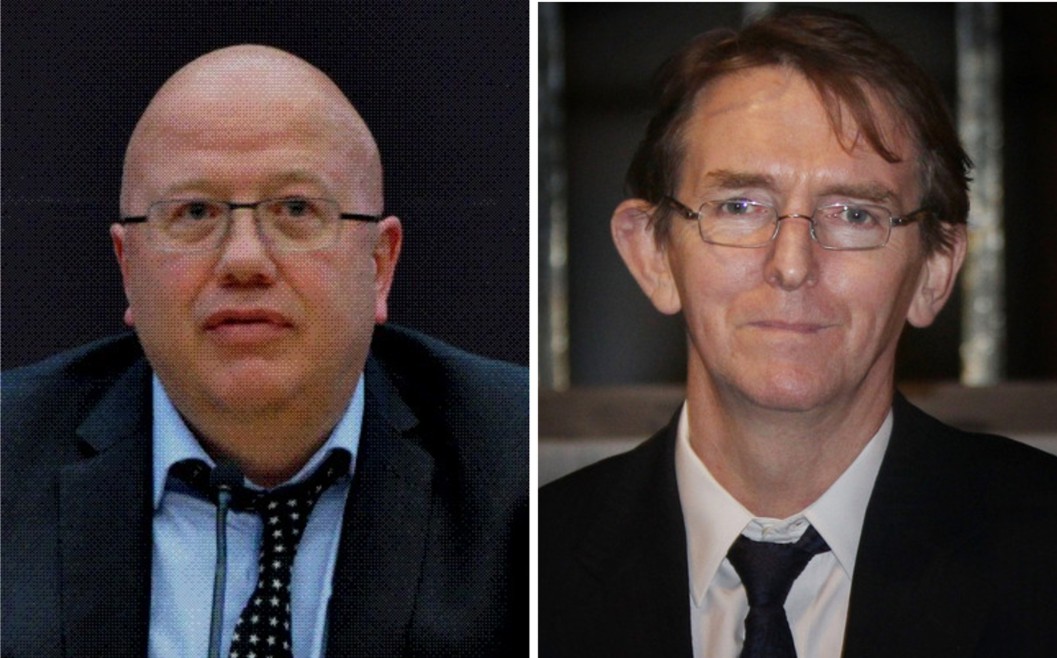
[Left, editor Chris Blackhurst of the Independent, right, editor Tony Gallagher of the Daily Telegraph]
1. Examine first some key happenings at the Knox/Sollecito trial
Throughout the trial which began back in January 2009 the defense teams often seemed down or depressed or distracted or floundering.
Reports surfaced in Italy that one or two of them might even have considered walking. Knox defense counsel Luciano Ghirga was reported as nodding off or distracted. Sollecito defense counsel Giulia Bongiorno was photographed seemingly showing some exasperation with Sollecito and at zero notice she missed several days in court.
Amanda Knox’s testimony over two days on the stand in June 2009 was widely seen in Italy as a disaster. From then on many in the court and throughout Italy believed this seemingly callous, evasive, forgetful girl had to have had a role in Meredith’s death.
Having failed to attend to observe any of the key forensic tests at the Scientific Police labs in Rome, the defenses were able to introduce some forensic witnesses who testified that there might, possibly, somehow, be contamination in the collection and tests which they chose not to witness, but they never came close to showing how.
By the summations in November 2009 both defenses seemed to be seriously floundering.
2. Fast forward to Friday 20 November 2009
What happened on 20 November might well have made it the defenses’ very worst day.
On that day during their summation the prosecution BEHIND CLOSED DOORS devoted an entire day to reconstructing how Meredith died and the events in the few hours before and since.
The presentation was closed because Judge Massei had ruled in favor of Meredith’s family to close the court to the media when any upsetting material was being presented. For example the results of the autopsy had been presented in closed court.
This resulted in the Massei judges and jury receiving a much more disturbing picture than the Italian public and especially the foreign publics ever did.
The Italian media pieced together what had been presented behind the closed doors on 20 November and Il Messagero and several other Italian newspapers published it several days later. You can read a combined summary in this post here.
To our knowledge none of that summary of events ever appeared in the US or UK media, so the full impact of the reconstruction felt by the jury and to a lesser extent by the Italian public was never felt at all by the US or UK publics.
This excerpt is from that post:
We have left out the depiction of the final struggle with Meredith, which is extremely sad and disturbing. In the evidence phase this was testified-to behind closed doors at her family’s request and we have never posted anything from those sessions….
23:21 - Amanda and Raffaele go into Meredith’s bedroom, while Rudy goes into the bathroom.
23:25 - A scuffle begins between Amanda, helped by Raffaele, and Meredith. The English girl is taken by the neck, then banged against a cupboard. Rudy Guede enters and joins in.
23:30 - 23:45 Depiction in the timeline and computer simulation of a horrific struggle with Meredith
23:50 - Amanda and Raffaele take Meredith’s mobile phones and they leave the apartment. Guede goes into the bathroom to get several towels to staunch the blood, then puts a cushion under Meredith’s head.
That simulation video was a second-by-second depiction of what the crime-scene specialists from the Scientific Police in Rome had concluded, from the position of Meredith’s body in the room, evidence traces and the placing of various objects, and the many wounds described in the autopsy.
It was extremely difficult and laborious to get just right, and every tiny movement of the four that it depicts in three-dimensional space had to be able to stand up unchallenged - as they did.
The fight with Meredith took a horrific fifteen minutes. It only ended when she was lying bleeding on the floor, her hands grasping her neck. She was locked in her room to die, with her keys and phones removed to make sure she could not save her own life.
This was not a minute or two of hazing and a slipped knife. The evident intention was to see her dead - and in the reconstruction it required THREE ATTACKERS to explain all the evidence points.
The prosecution never entered the video into evidence so it could not be leaked to the public (the Sollecito family already stood accused of leaking one video) but the effect on the jury seems to have been profound and the defenses could do nothing to blunt it.
The lone wolf theory was well and truly dead in that courtroom and a perception of three attackers was well and truly alive. The defenses did what they could in their summations but they were unable to shake the perception of a depraved three-against-one attack.
A few days later a verdict was announced. By a UNANIMOUS verdict Sollecito and Knox were found guilty.
3. Fast forward to the first-level appeal before Judge Hellman in 20011
Judge Sergio Matteini Chiari, the most senior judge in the criminal division, was appointed to preside over the appeal.
He was very experienced at presiding over murder trials and appeals. What happened next surprised many among the judges and prosecutors and Italian reporters and the Italian public generally. From the Italian Wikipedia:
Although the Assize Court of Appeal was to be chaired by Dr. Sergio Matteini Chiari, Chairman of the Criminal Division of the Court of Appeal in Perugia, in circumstances not well understood Dr. Claudio Pratillo Hellmann, who chairs the Labor Chamber of the Court, has been called on to preside over the appeal court,
The judge to the side of the main judge, Dr. Massimo Zanetti, came from the Civil Section, and both had had limited experience with criminal trials both rather remote in time (only the cases of Spoleto and Orvieto).
Judge Hellman readily consented to the defense requests. First to re-examine several witnesses previously heard on the stand during trial (primarily Mr Curatolo) and two new ones (Alessi and Aviello) intended to show that Guede or Aviello’s missing brother could have attacked Meredith with unknown others.
And second to appoint two independent experts who would re-examine the DNA on the large knife found in Sollecito’s apartment and the DNA for which traces were collected in Meredith’s room and the methods used for processing them.
The examination of the witnesses seemed to end indecisively, but the vague suggestions of the independent consultants that there COULD have been DNA contamination - never proven - was accepted readily by Judge Hellman.
The reconstruction and the showing of the simulation which the trial jury sat through in later 2009 was not repeated by the prosecution at the first appeal in late 2011. Judge Hellman showed no inclination to sit through the full depiction of the day or the horrific 15-minute attack on Meredith.
So the explanation of all the evidence points in the room and on Meredith’s body was never solidly brought home solidly to Judge Hellman or his jury. In his verdict he overturned the outcome of the first trial, provisionally pending any Supreme Court ratification, and he handed Amanda Knox a three-year sentence for framing Patrick Lumumba.
Having refused to see the reconstruction, he could very torturously argue that the attack on Meredith could have been carried out by a single person. If he and his jury had actually watched the video, they could never have argued that.
4. Fast-forward to the grounds of Dr Galati’s appeal to the Supreme Court
The Umbria Chief Prosecutor’s grounds for appeal were spelt out by him at a new conference in Perugia on Monday 13 February 2012. The PMF translation team will soon have the full document ready in English.
The summary of the grounds for appeal below is translated from the Umbria24 report and to our knowledge NO English-language website except this one and PMF has ever reported what are the full grounds.
Meredith case: the prosecution appeals to Cassation: the acquittal verdict should be “nullified”.
For the Chief Magistrates of the [Umbria] Prosecution, “it was almost exclusively the defence arguments which were taken heed of”
By Francesca Marruco
The first-level conviction verdict was “complete and thorough” while the verdict of the second-level is “contradictory and illogical”. For this reason, the General Prosecution of Perugia asks the Cassation to revoke or invalidate it.
“We are still extremely convinced that Amanda and Raffaele are co-perpetrators of the murder of Meredith Kercher” said the Chief Prosecutor of Perugia, Giovanni Galati and the Deputy Chief Prosecutor, Giancarlo Costagliola.
Verdict that should be revoked “The second-level verdict should be annulled/revoked…. There are precise reasons for revoking it”, Mr Galati went on to say. In the Hellman reasoning report on the verdict with which the second-level judges acquitted the ex-boyfriend and girlfriend “there are so many errors, and many omissions. There is inconsistency in the grounds for judgement, which brings us to nothing.”
“It is as if they had ruled ex novo [anew] on Meredith’s murder” added the Deputy Prosecutor, Giancarlo Costagliola, “basing their decision solely on the arguments of the defence.”
“Normally the appeal judge evaluates the reasoning procedure of the first-instance judge and compares it to new elements. But this one missed that out altogether: there is no comparison between the checks carried out in the first and second instances. Only what was carried out during the appeal was evaluated.”
Only defence arguments were taken heed of For the magistrates, in fact, the second-level judges “took heed, almost exclusively, of the arguments of the defence consultants or the reconstruction hypotheses that were largely to the benefit of the defense theses”.
The prosecutors who authored the appeal [to Cassation] also criticized the “method used”. “The first-instance verdict”, they wrote, “was summarized in just a few lines”,
“The verdict [which we] challenge completely ignored all the other aspects which corresponded with the accusation’s hypothesis, all the aspects which, on the contrary - as was seen in the reasoning report of the first-instance verdict - had been rigorously pointed out and considered by the Assizes Court [trial court] in its decision.”
“In examining the individual [items of] evidence, the challenged sentence has fallen into consistent procedural error in the weaknesses and evident illogicality of the grounds for its decision.”
Prejudice For the General Prosecution magistrates, the second-level [first appeal] judges appear to have shown “a sort of prejudice” with the “infelicitous preamble of the judge [the author], who is supposed to be impartial”, when he declared that “nothing is certain except the death of Meredith Kercher”, which to the others [Mr Galati and Mr Costagliola] is nothing more than “a resounding preview/forecast of the judgement” and a “disconcerting” affirmation.
The ten points The reasons for the appeal to Cassation which Perugia’s General Prosecution presented today against the acquittal verdict of Amanda and Raffaele are based on ten points of the second-level verdict.The first is the lack of grounds for the decision, in the decree of 18 December 2010, to allow the forensic testimony/expert witness in the appeal judgement.
The second, in contrast, concerns a contrary decision: the decision to not allow a new forensic investigation requested by the prosecution at the end of the ruling discussion. In the appeal to Cassation it is written that the Appeal Court’s rejection reveals “contradictoriness/contrariness and demonstrates manifest illogicality in the grounds for the judgement/reasoning report”.
The other points deal with the decision by the Appeal court of Assizes of Perugia to not hear the witness Aviello, also the definition of “unreliable” [in the Hellman Report] with reference to the witnesses Roberto Quintavalle and Antonio Curatolo, also the time of death of Meredith Kercher, also on the genetic investigations.
As well as the analyses of the prints and other traces, also the presence of Amanda and Sollecito in via della Pergola, also the simulation of a crime [the staged break-in], and also the exclusion of the aggravating circumstance of the crime of “calumny”.
Missing assumption/acceptance of decisive evidence In the appeal to Cassation there is also mention of the “missing assumption/acceptance of a decisive proof”
In other words, of that proof [presented at trial court] which consisted of “the carrying out of the genetic analysis on the sample taken from the knife by the experts appointed by the Court during the appeal judgement, who did not carry out the analyses of that sample, thus violating a specific request contained in the [orders given to them] when they were assigned to the expert-witness post”
“In the second-level [Hellman] verdict”, the magistrates said, “the judges sought to refer to this in their own way, by speaking of an “experimental method” by which these tests/checks could be carried out.
But this is not the case”, said Deputy Chief Prosecutor Giancarlo Costagliola: “Dr Novelli [the prosecution’s DNA consultant at appeal] spoke of cutting-edge technology, not of experimental methods”.
So Dr Galati, himself formerly a deputy chief prosecutor at the Supreme Court who for years handled nothing but Supreme Court cases and knows what constitutes a sound appeal argument, argued that Judge Hellman had made ten serious mistakes. (Aviello claimed in court that he had been bribed; instead of investigating, Judge Hellman very quickly move on.)
But even worse, that Judge Hellman had illegally vastly expanded the scope of the appeal. And he had illegally appointed the independent DNA experts.
Because of Hellman’s alleged sloppiness and overreach, the defenses now stood to lose EVERYTHING they thought they had gained - and had been so noisily jubilant about, especially to the media in the US. An arrogance not taken kindly to in Italy at all.
5. Fast forward to English language press reports of the past few days.
Nick Squires may have been the first to carry the report quoting unnamed sources in the Daily Telegraph.
Two prosecutors in Perugia, where Miss Kercher was murdered, face accusations of wasting 182,000 euros (£150,000) of public money by commissioning a controversial 3D video which purported to show how the murder unfolded.
The contentious video, which defence lawyers said was based on circumstantial evidence, showed Miss Kercher being held down and stabbed to death by Miss Knox and her two co-accused.
The Leeds University student and her alleged murderers were represented in the 20 minute film by animated ‘avatars’. It was played on a big screen to the judge and jury in the original trial in 2009.
The National Audit Office is now investigating the prosecutors, Giuliano Mignini and his deputy, Manuela Comodi, on whether the video was a necessary part of their case.
If found culpable they could have to pay the money back to the prosecutors’ office.
Really? Accusations? Wasting? Controversial? Purported? Contentious? Now investigating?
Note that Nick Squires didnt name his sources. He didnt explain why he claimed the video simulation was controversial. (It wasn’t at all controversial at trial in 2009.) He didnt seem to know who had made the accusations or how or when they had been made or to who.
He failed to mention that the video was played behind closed doors, and that the defenses had no comeback to it. He said it depicted Knox, though in fact it deliberately didn’t. He didn’t explain that the depiction of the fight lasted 15 minutes. He didn’t explain that the depiction of three attackers was overwhelmingly convincing to Judge Massei and his jury.
Nick Squires’s report was nevertheless comparatively brief and restrained in contrast to that of Michael Day which came next. His very much embroidered version was published in the UK Independent. The accusatory tone and serious charges in Nick Squires’s and Michael Day’s reports were then picked up without checking by a large number of American and European media outlets.
See the reports here and here and here and here and here and here and here .
Note that not one of these reports was checked out in Italy, and that all these reports slam Mr Mignini (yet again) and indicate that this was an OFFICIAL accusation of “wasting public funds”. Many US reports wrongly state that the British audit office is investigating.
Michael Day claimed that “Agostino Chiappiniello has said he suspects the two of inappropriately spending €182,000 (£148,000) on a crude and cartoonish 20-minute video,”
Really? Agostino Chiappiniello, did you tell Michael Day precisely that?
Michael Day then states that “In both trials [Mr Mignini’s ] interventions were notable for the outlandish motivations and personality traits he attributed to the defendants. He promoted the idea that the murder was the result of a sex-game that got out of control, despite having little or no evidence to support the theory.”
Really? Actually Guede and Knox and Sollecito were all CONVICTED of a sex crime at trial, because to their judges and juries that is what the evidence inescapably pointed to.
And Michael Day concludes with yet another misleading statement (see above on Dr Galati’s appeal for the correct facts which he seriously garbles here.):
Judges at the Cassation court may only overturn the first-appeal verdict on technical grounds. Thus, no new evidence may be introduced and the prosecution’s room for manoeuvre is limited. The pair could not be retried for the same crimes.
Really? But nobody is talking about the pair being retried for the same crimes. This does not arise. Under Italian law they STILL stand accused of the same crimes as they were before trial back in 2009 until the Supreme Court signs off on their case.
6. Fast-forward to the ITALIAN reports of the past two days
Translation by our main poster Jools from an Umbria24 report, posted on Wednesday, which tells a very different story.
[There was several months ago]”¦ a complaint from “a group of private citizens” who did not sign their names and surnames about an alleged misuse of public money….
No comment from the two prosecutors of Perugia, no comment on this news.
As we have learned the prosecutors have not received any legal papers regarding the investigation and they heard of the news from the press.
Who will pay? To decide if the expense was adequate for the State coffers will be the task of the prosecutor at the Court of Audits of Umbria.
Meanwhile if the Supreme Court were to overturn the judgment of the Perugia appellate court, the costs would be paid by the two accused [Knox and Sollecito].
If instead the Supreme Court were to confirm the acquittal, the bill for 182 thousand euros would be borne by the Italian State.
7. In summation
Quite a fizzle. The prosecutors are NOT quaking in their boots. They didnt even know about it. And the full force of Italian justice does NOT have them under the microscope.
- The anonymous complaint was filed over two months ago. Nick Squires and Michael Day sure did not make that clear.
- If the enquiry is actually pursued (not at all certain) then it is Amanda Knox and Raffaele Sollecito who could in fact be stuck for the costs (plus VAT) of producing the video. Nick Squires and Michael Day sure did not make that clear.
- The Corte dei Conti is not the equivalent of a criminal or civic court, it is essentially an investigating tribunal. Nick Squires and Michael Day sure did not make that clear.
- The Corte dei Conti has so far not accused anyone of anything, and it may never do so. It sure doesn’t seem to regard the matter as urgent. Nick Squires and Michael Day sure did not make that clear.
- In fact it has taken over two months to, well… not even assemble the evidence or bother to get in touch with Mr Mignini or Ms Comodi. Nick Squires and Michael Day sure did not make that clear.
On the same basis Judge Hellman could in theory be accused of incurring TWO huge cost over-runs.
- One for running his appeal court only on saturdays to suit just one defense lawyer, when the overtime costs to Italy became huge - substantially more than the cost of the video. Nick Squires and Michael Day sure did not make that clear.
- And one for (according to Dr Galati) illegally appointing the two DNA consultants - the costs of that investigation to Italy became much more than the cost of the video. Nick Squires and Michael Day sure did not make that clear.
The reconstruction video is so powerful and accurate that it could, if it is watched by the Supreme Court in Rome or a new appeal court in Perugia, be quite devastating to the defense of the two accused. This is because it depicts the full cruelty of the attack on Meredith - and it shows that THREE people had to have attacked her.
So who filed the anonymous complaint against Mr Mignini and Ms Comodi? And who used Nick Squires and Michael Day as puppets to make a private claim look official, and make that hoax go viral? We are sure Dr Galati will have all the answers before many days go past. Calunnia charges might apply.
Someone must REALLY fear that Sollecito and Knox will be cooked if that video reconstruction ever gets shown again. Case closed? At one stroke.
[Below: Knox and Sollecito, who could be billed over $300,000 for the reconstruction video]
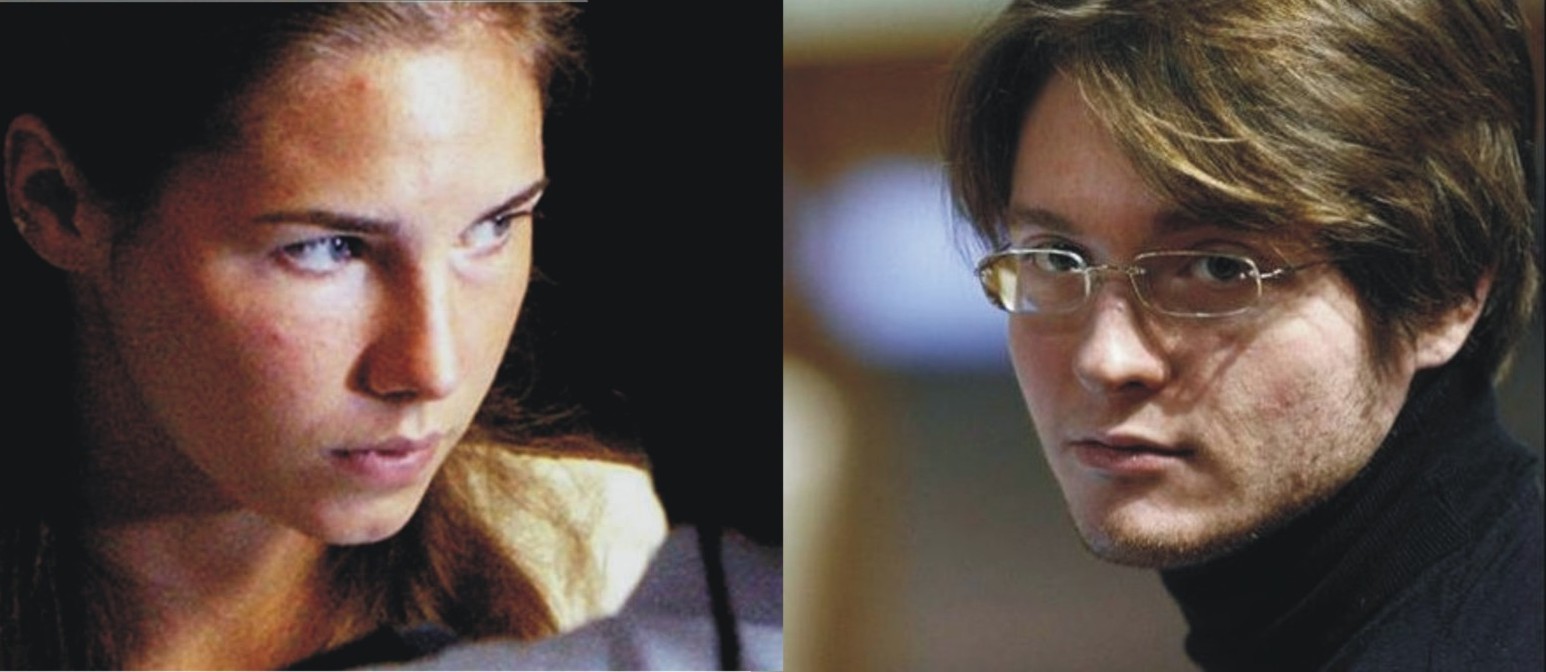
Sunday, June 19, 2011
The Massei Sentencing Report For Knox And Sollecito: Part 1 Of A Summary In 4 Parts
Posted by Skeptical Bystander
Why This Long Summary
The full Massei Report can be found here.
The wiki page controversy surrounding the murder of Meredith Kercher rages on in a tiny corner of the online universe, here is our own contribution to the debate.
It is a 4-part summary of the Massei report, the document that sets forth and explains the Court’s reasons for unanimously convicting Amanda Knox and Raffaele Sollecito for their role in the murder of Meredith Kercher, Knox’s roommate, after a long, thorough and fair trial.
Please click here for more
The Massei Sentencing Report For Knox And Sollecito: Part 4 Of A Summary In 4 Parts
Posted by Skeptical Bystander
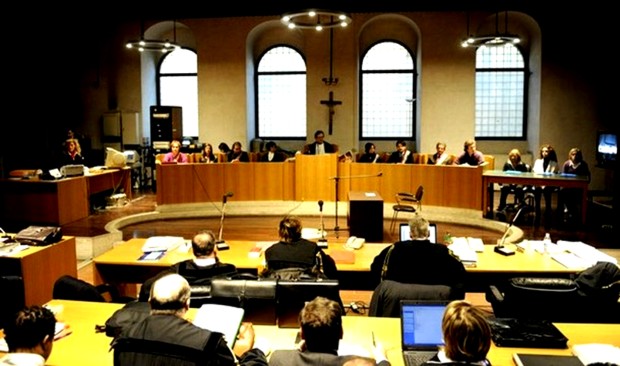
The full Massei Report can be found here. Continuing on with our summary:
9. Conclusions reached by the court
The court concluded that Amanda Knox and Raffaele Sollecito had colluded with the main protagonist, Rudy Guede, in murdering Meredith Kercher and that this was in the context of a sexual assault.[390-393]
The evidence that Guede was involved in the murder included his bloody handprint found on a pillow in Meredith’s room, and his DNA found on a vaginal swab taken from Meredith, as well as on the cuff of Meredith’s sweatshirt and on a strap of her bra and on her purse. Further biological traces of Guede were found on the toilet paper in the larger bathroom. His bloody footprints were found in the corridor leading out from Meredith’s room to the front door of the apartment. All this evidence pointed to Guede having been in the apartment, crossing the living room to the larger bathroom (where he used but did not flush the toilet), passing back through the living room and the corridor to Meredith’s room, where he committed the murder, then exiting directly along the corridor and through the front door.[43-44]
The court next considered whether Guede had entered the apartment through the broken window in Romanelli’s room.[45] The defense had argued that Guede had previously been found uninvited inside a Milan nursery school and had been in possession of items stolen from a Perugia law office which had been burgled by someone who broke a window with a rock. He had also been identified as the person who had broken into a house and threatened the occupant with a knife. The court noted this evidence but also highlighted some marked differences from the current case, and also the fact that there was no direct evidence that linked Guede to the law office burglary. In addition, the court made a detailed analysis of the evidence of the ‘break-in’ and concluded from many pieces of evidence (see section 8) that the ‘break-in’ had been staged and that no-one had entered the house through the broken window. In fact, the conclusion drawn by the court from this staging was that it had been done in order to throw suspicion onto a supposed intruder who did not have a key to the front door.[46-55]
The court next considered whether Guede might himself have staged the break-in, which might have happened if Meredith had let him in through the front door and he intended to throw suspicion onto a supposed burglar. The court rejected this hypothesis: if Guede was alone in the apartment, following the murder, it is improbable that he would have stayed longer than necessary, faking a break-in, when the other occupants, who would recognise him, might return at any moment. Further doubt is cast on this scenario by the fact that some aspects of the ‘break-in’ are superficially similar to other crimes associated with Guede, so might lead investigators directly to him. Finally, the court doubted that Meredith, alone in the apartment, would have let Guede, whom she barely knew, in through the front door, let alone waited in her own bedroom while he used the bathroom.
The conclusion of the court was that Guede was let into the apartment by somebody, other than Meredith, who had a key to the door and that the ‘break in’ was likewise staged by someone who had a door key. Laura Mezzetti was away from Perugia on the night of the murder and Filomena Romanelli was staying elsewhere, at a birthday party. This left Amanda Knox who had a key to the front door and lacked an alibi for the time of the murder. She, according to the court, was the only person who could have let Guede into the apartment and who also would have a motive for staging the ‘break-in’ to simulate the forced entry of an intruder.[56-58]
The court noted the ‘intense’ relationship between Knox and Sollecito, and the fact that they were both using drugs.[365] After Patrick Lumumba sent Knox a text, shortly after 8 pm on November 1, 2007, telling her that there was no need for her to go to work that evening, the pair of them were free of any commitment that evening. By 9:15pm they had eaten dinner and washed up (as witnessed by Sollecito’s father’s earlier phone call), turned off their mobile phones and made no further use of Sollecito’s computer. The court’s conclusion was that this point, they both left Sollecito’s apartment and were seen by the witness Curatolo, several times, around the Piazza Grimana.[359]
Guede already knew Knox and was attracted to her. The court believed that around 11pm, on the night of the murder, Knox, accompanied by Sollecito, let Guede into her apartment, possibly having first met him in the nearby square.[361] The reason for Guede’s visit to the apartment could not be known for certain: perhaps he was going to spend the night there as had happened on another occasion, although in the downstairs apartment; perhaps to hang out with Amanda and Raffaele for a while and to use the bathroom; maybe he had come to look for his friends in the downstairs apartment, and finding them absent, called on the upstairs apartment.[363] What is certain is that Guede used the toilet in the larger bathroom.[364]
Meredith had arrived home, alone, earlier in the evening and was most likely reading or studying in her own bedroom. The court found it probable that, having used the bathroom, Guede went into Meredith’s room, intent on making sexual advances, which were rebuffed. It was probably at this point that Knox and Sollecito joined Guede.[365-366]
The court concluded from the presence of Guede’s DNA in her body, that Meredith’s attack involved a sexual assault: the evidence that it was not consensual sex was deduced from other specific injuries as well as the obvious violence. Based on factors such as Meredith’s strength and physical fitness, and the way she had been undressed, they believed that she was the victim of multiple attackers.[369-372]
Based on the forensic evidence, the court believed a sequence of events in which Meredith refused to accept an invitation of an erotic-sexual nature and was then grasped by the neck by her assailants, for the purpose of intimidating her. When this intimidation was unsuccessful, it led to an escalation of violence, which involved the small stab wound to the neck.[164]
It is likely that it was at this point that Meredith’s trousers and underwear were removed by her assailants and that she was sexually assaulted. Her top was lifted up and rolled up towards her neck and there was an attempt to unfasten her bra which, despite her resistance, was eventually cut off. A pillow was placed under Meredith to allow further sexual activity: from Guede’s bloody hand print on the pillow, it was deduced that Meredith was already bleeding at this point. Part of the bra, including the clasp which bore Sollecito’s DNA, was found under the pillow, which indicates that this was cut off before the pillow was placed.[164-165]
It was, the court believed, around this time that Meredith screamed loudly, as confirmed by the evidence of Nara Capezzali and Antonella Monacchia, which placed the time around 23:30 pm. The response of the assailants was the compression of the upper airways, by pressing a hand over Meredith’s mouth and nose, and then inflicting the deep knife wound to the right side of the neck. Their conclusion was that death occurred a few minutes later, and was caused by asphyxia resulting from the major neck wound from which there was bleeding into the airways, impeding respiratory activity. This was exacerbated by the severing of the hyoid bone ““ also attributed to the knife wounds.[165]
In the court’s opinion, the initial attempt had not been to kill Meredith, but there was “a crescendo of violence” in which the assailants simply accepted the risk of death, constructively transforming their initial non-homicidal intent into a pro-homicidal intent characterised by reckless malice.[171]
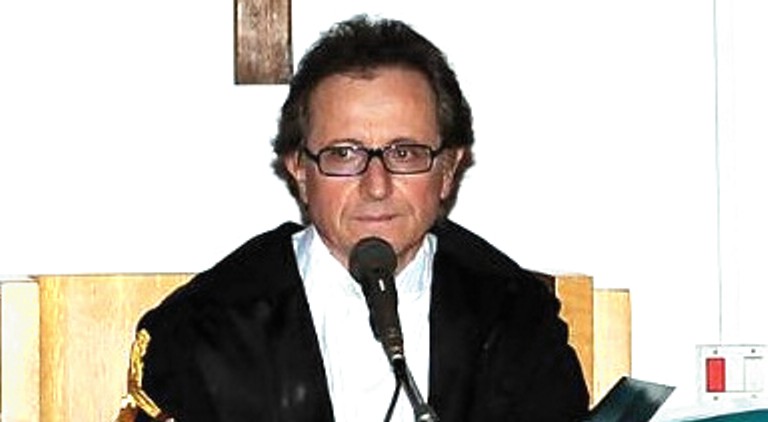
Regarding the murder weapon, the court found it difficult to accept that the wounds of various sizes were all made by the same assailant and the same knife. Their conclusion was that the smaller wounds were made with a pocket knife that has never been identified, but the largest (and fatal) wound was made with the knife which was subsequently recovered from a drawer in Sollecto’s house and which bore traces of Meredith’s DNA on its blade and Knox’s on the handle (the “double DNA knife” discussed in section 7.1).
The court believed that, following the murder, the murderers went into the smaller bathroom to wash off some of the blood as witnessed by the traces of blood found there. They rejected the possibility that these were older traces, left from some previous incident, as Knox had testified that that bathroom was clean when she left on the afternoon of November 1.[278] In the process of cleaning themselves, the murderers must have touched the door and the light switch, leaving a dribble of blood on the former and stains on the latter.[281] The bloody footprint on the bathmat (which matched the size of Sollecito’s foot), indicates that whoever went into this bathroom was barefoot, and must also have been barefoot in Meredith’s room.[279] While in the bathroom, it was deemed likely that the murderers scrubbed their hands, thus leaving mixed traces of Meredith’s blood and their own DNA in the sink and the bidet.[279] The court noted that the traces found in the small bathroom not only tested positive for blood, but also included a mixture of Knox’s and Meredith’s DNA. They concluded it was Knox who, on the night of the murder, had washed off Meredith’s blood in the sink and in the bidet.[280]
The court considered the traces shown up by Luminol tests in Romanelli’s room, Knox’s room and the corridor. Luminol tests positive for blood but can give false positive readings for other substances, including fruit juice, rust and bleach. Other tests for blood were applied to the same traces and proved negative, but were noted to be less sensitive than Luminol. The court considered the alternative interpretations of the Luminol results: it found it improbable that the traces were caused by such things as fruit juice or rust - particularly as there was no explanation for why such substances would be in all three locations. The possibility of bleach having been spread through the three rooms was more feasible, but in that case, the court wondered why it would not appear elsewhere in the apartment. Also there was no evidence (smell for example) that bleach had been used.
Furthermore, the traces contained biological material, although it could not be proved to be blood. Considering all the possibilities, and the fact that there were copious amounts of blood at the murder scene, the court believed that the Luminol traces were indeed blood. They noted that the traces tested positive for Knox’s DNA and, in two cases, also included Meredith’s DNA. Their conclusion was that Knox had washed her bare feet in the bathroom, but some residue of Meredith’s blood had remained on the soles, and she had then walked into her own room, into Romanelli’s room and passed through the corridor, leaving the traces which were discovered.[281-286]
The conclusion of the court was that Guede had left immediately, but Sollecito had then brought in a big stone from the surrounding area and he and Knox had broken the window in Romanelli’s room with it and attempted to fake a break-in. They had gone back into Meredith’s room, covered her body with a duvet, then locked her door.[381] The court believed that the murderers took Meredith’s mobile phones, left the apartment and dumped the phones in a nearby garden. This must have happened before about half past midnight, as can be deduced by the phone records.[383] Knox and Sollecito returned to his apartment where he made a very brief (4 second) use of his computer at about 1am.
Contrary to the statements of Knox and Sollecito, his computer was in use for half an hour from about 5:30am the following morning, and he turned on his mobile phone at about 6am. The court believed that Knox and Sollecito returned to the murder scene that morning, with Knox perhaps having bought cleaning materials from Quintavalle’s shop at about 07:45.[384] There was evidence that cleaning had taken place: for instance the bath mat marked with a bloody footprint could only have been reached by taking steps that should also have left other footprints. None were found, so the logical conclusion is that they had been cleaned up. Even the drip of blood left on the internal edge of the bathroom door was said to seem like the remainder of a much larger trace.[384]
In conclusion, the court stated that all of the elements put together, and considered singularly, create a comprehensive and complete framework without gaps or incongruities and lead to the inevitable and directly consequential attribution of the crimes to both the accused.[388]

